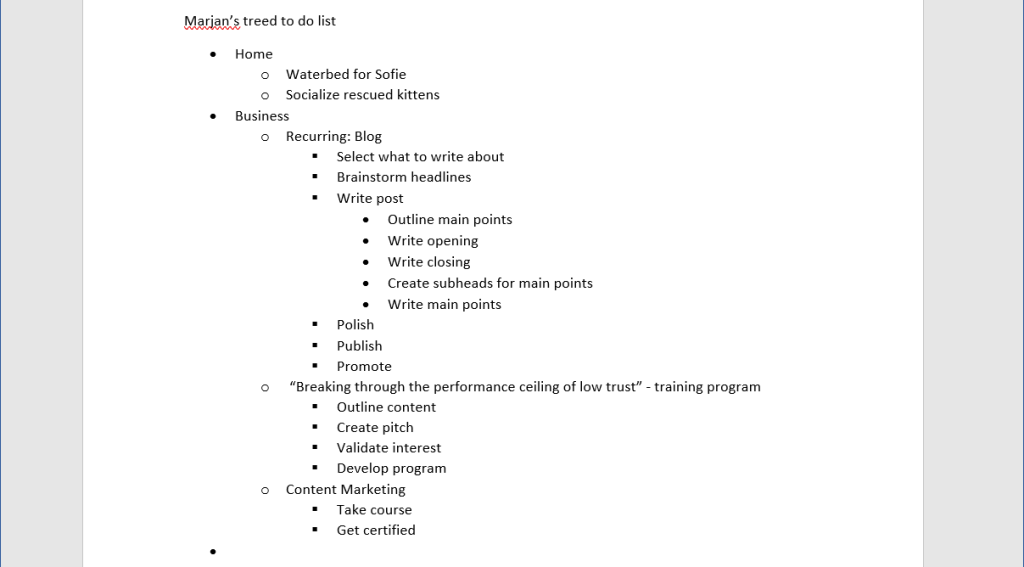It’s early morning. The day stretches ahead of you. You glance at your to do list and your heart sinks.
There is so much to do and so little time to do it. You have no idea how you are going to get through it all.
It seems to have taken on a life of its own. Growing faster than you can strike things off.
Having a to do list sounded like a good way to get back on top of what you want to accomplish.
But now, it feels like it’s getting on top of you. You feel overwhelmed and frustrated and constantly behind.
If it weren’t for the important achievements it reminded you to accomplish, you would ditch it.
If only you could get back in control and feel like you were in the driver’s seat.
What if I told you, you can?
I have been where you are. The absolute extreme came when I had 20+ boards, each with 10+ lists covering different angles of what I wanted to do. And those were just to help me manage my personal life and hobby projects.
I grew to hate them. They were a constant reminder of everything I hadn’t done. It didn’t even matter that I had moved on and wasn’t even interested in something anymore. I still felt bad for not following through.
It was high time to take a different approach. Stumbling and falling I have put together strategies that make my to do list work for me instead of the other way around.
You too can use them and get back into the driver’s seat.
Get back behind the wheel

1. Go cold turkey
You can go cold turkey: throw your list in the bin and start afresh.
This is not for the fainthearted.
Still, it’s less perilous than it may sound. Anything important you’ll likely remember. And what you don’t, will either come back in due time or isn’t important.
2. Knife ‘m mercilessly
If going cold turkey sounds too radical, the other option is to take a knife to any item that meets one of the criteria in the list below.
- Let your memory desert you
Slash off any item that got on your list more than two weeks ago. If you haven’t gotten to it yet, it’s not important, not urgent or both. If it actually is important, see “Sooth your fear of memory loss”. - Ignore your chore
Delete any item that even smells like a chore: anything you do once a month or more. If you want to remind yourself of these to dos, write them on a calendar with the weekdays for 4–5 weeks. It’s easy to make one out of a note board or a big piece of carton or thick paper. - Don’t ask questions
If you have to ask yourself what it was about, knife it. It’s too cryptic and it’s not worth spending any cognitive power trying to decrypt it. - Do it yourself or not at all
Bin any item that requires someone else. If you really, really need it done, rephrase it so it is something you can do yourself. For example “service car” or even “get car serviced”. Unless you are a car mechanic, “call garage to make appointment” is more actionable for you. - Wait for no one
Remove any item you can’t proceed on because you are waiting for someone else. These items clutter your list and waste your energy every time you read them. Having a “waiting for” list is one of the things I copied from “Getting things done”. I like it because it also puts everyone I need to chase in one place.
Be ruthless and merciless: when in doubt, slash it off your list. Don’t think too long and don’t worry about slashing off too much. It it was important, it will make its way back on in due time.
There are two ways to use these. You can go through item by item or criteria by criteria. The first means you go through the list once. The second means several rounds through your — ever shortening — list. I’ve found the second works better for me, because it makes me focus on one criteria and that allows me to work through the list faster.
3. Keep it short and sweet
Aim for a short to do list. Keep it to about what you can do in a week. And only list what you most want and need to get done.
When you put more on, things will start falling by the wayside. And what falls off usually is what’s most important. Simply because we tend to allow urgent issues to overshadow the important ones.
And don’t worry about those urgent matters. They really don’t need to be on your to do list. They have their own, often obnoxious, way of getting your attention.
4. Sooth your fear of memory loss
Did you have things on your list that are important to you? That you realistically won’t get to in a week, or even two weeks, but that you don’t want to forget?
You not only want these ideas off of your to do list, you also want them out of your head. The trick is to let your subconscious know they are ‘safe’, so it can stop pushing it into your conscious mind.
A spark file is an excellent tool for that.
It’s a document where you keep your bright ideas — your sparks. You add the idea plus (links to) information that will help you get started when you do get to it.
Get on the road

Now that you have a to do list you feel in control of, it’s time to get back on the road and start driving. But where do you start? What to do first and what can be left for later? And how do you even start on tasks that are so humongous, they leave you feel deflated?
The following strategies have helped me sort that out.
5. Apply the “Moscow rule”
I’ve found the “Moscow rule” a powerful tool to prioritize what’s on my plate.
It’s a simple rule. You mark each item on your list for one of Moscow’s consonants:
- M stands for Must
Use it for things you absolutely, positively have to accomplish or you’ll forever regret it. Joking aside, use it sparingly, because another way to look at it is that if you don’t accomplish them, your week can’t be a success, and if you do complete them, your week can’t be ruined regardless of what else does or does not happen. - S stands for Should
It’s for items that are not quite a Must. They are as important, but you wouldn’t break into tears if you’d have to postpone them a little. For example if you’d have to roll them over into next week. - C stands for Could
Use it for items that you would like to get done if and when there is time left after doing your Must and Should items. - W stands for Won’t
If you weeded out your to do list sufficiently ruthlessly — or started with a clean slate, you won’t have any of those.
To make it easy for yourself to stick to your priorities:
- Rearrange your to do list with the Must items at the top, followed by the Should items and the Could items at the end.
- Start working on Must items only.
- Only work on Should items when all Must items are completed.
- Only work on Could items when all Must and Should items are done.
There is only 1 exception for this: when you are waiting on other people on all of the unfinished items in a category. For example when you have 5 Must items, 3 of them are done and you are waiting for someone to get back to you on the other 2. In that case it would of course be okay to start work on a Could item. Just remember to go back to any unfinished Must item as soon as you get what you needed.
6. Break ’em down
You know the feeling you get when you face working on something that seems an insurmountable mountain? Or one that’s so vague that you can’t see the path ahead?
Even getting your to do list under control, can seem like climbing Mount Everest.
Not a nice feeling. It stops you dead in your tracks.
The trick is not to tackle such tasks as a single one. Divvy them up. Break ’em down into steps that are clear and feel doable. Add each individual step to your list.
Now, when you come around to any of these steps, you will sail right through them.
7. Do the legwork up front
Ever had an item on your list to call someone and didn’t have their number?
Or you have to make hotel reservations and you don’t have all the names of the people who need a room? Perhaps you don’t even know exactly how many people need one?
Or you have the information somewhere but not immediately at hand — like buried in your inbox or your email archive?
Were you tempted to move on to the next item?
I was.
Having to hunt for the information you need to complete a task, just as much kills your momentum as not knowing where to start.
The answer is to do the legwork upfront.
Find the telephone number when you add the item to call someone next week. Add the email with the names of people who need a room to the item to make reservations, or add a link to that email. If you don’t have those names yet, ask the person who knows and put the “make reservations” item on your “waiting for” list.
8. Apply the “Birds of a feather” principle

When you have a bunch of to dos that are all related — for example after breaking down one of those big insurmountable tasks— it’s a good idea to keep them together on your list.
Keeping them together makes it easier to stay with something and finish multiple to dos towards the same goal.
Even better: create a treed list.
Using a treed list helps you think when you are breaking down tasks and it visually shows how they are all related.
You can easily do this using indentation or tabs. On paper, in a word processor or a text editor. Whatever is your tool of choice.
Stay in the driver’s seat

Now that you are back to driving confidently, you don’t want to drive just anywhere. You don’t want to go just anywhere, you want to decide where to go. The following tips will help you stay in the driver’s seat.
9. Become a boundary bully
Boundary bullies are very good at saying ‘no’ (though they don’t do it very nicely). To stay in the driver’s seat, you want to take a page out of their book. Make ‘no’ the default to everything that you could do. Only say ‘yes’ to what you truly want to do: the things that make today or tomorrow better for you.
10. Let shiny new objects gather dust for a while
Don’t run with every bright new idea that crosses your mind. Leave it alone for a while. Let it gather some dust. If it still shines through the dust after a couple of days, weeks, or even months, that’s soon enough to take action.
If you’re worried about forgetting a good idea when it comes along, write it down. Add it to a spark file as I mentioned earlier. That way your mind can let go off it and it will still be there for you to consider when you are looking for interesting new stuff to work on.
11. Mimic Tim Ferriss’ approach to getting sh*t done
Are you prone to procrastination? Then you are not alone. I am. Interestingly, some of the most productive people are self-confessed procrastinators.
Tim Ferriss’ approach is to start each day with picking at most 3 to 5 things to do that for which you can answer ‘yes’ to at least one of these questions:
“If this were the only thing I accomplished today, would I be satisfied with my day?”
“Will moving this forward make all the other to-do’s unimportant or easier to knock off later?”
(Following the “Moscow rule” these would be your “Must” items.)
Then — and that surprised me — pick just ONE to work on that day for 2–3 hours straight, preferably as the first thing you work on.
Whenever I follow this advice, I create momentum I didn’t know was possible before I encountered it.
You can make this work for you too. Maybe you can’t block off 2–3 hours, but you can certainly work first on what’s most important to you. And that will surely get you moving and creating results.
12. Don’t delete, mark complete
The longest journey starts with a single step, but you only reach your destination if you keep taking steps.
The bigger your goal, the longer your journey and the more steps you need to take. It’s easy to get discouraged along the way.
You can avoid that by celebrating every way point en route to your destination and looking back regularly to see how far you’ve come: what you’ve already accomplished.
Not deleting items as I complete them, but marking them complete, has done wonders for me. It makes it easy to celebrate what you’ve accomplished.
13. Wash, rinse and repeat regularly
Your to do list will quickly get out of control again, unless you take an active role to keep it in check.
That’s where a weekly review comes in. A practice advocated by every productivity guru out there. With good reason. It helps keep you on track.
- Celebrate what you accomplished.
- Reflect on what didn’t get done. Did you jam in too much? Did you procrastinate more than you would like?
- Take out the garbage. Remove any items that didn’t get done and are no longer as important.
- Consider what next week looks like in terms of time commitments and what that means for what you can realistically achieve.
- If there is room for new items, dust off the shiny new objects you parked in your spark file and pick a few that will move you closer to your goals.
14. Remember who’s boss
When you get your to do list in shape and start reaping the benefits, you will feel wonderful.
There is a caveat, though.
The reward of marking something complete, or the urge to have your tasks in the perfect order, can lead you to spend more time on your list than on doing what’s on it.
When you unexpectedly achieve something as the result of an opportunity you’ve been waiting for, then it is absolutely valuable to add it and feed the celebration stage of your weekly review.
Other than that, however, keep in mind that it is just a tool, it is supposed to serve you, not the other way around.
Get your to do list to work magic for you
Using a to do list can quickly lead to feeling overwhelmed and frustrated by it. But there is no reason to dread looking at your to do list.
Start with cleaning it out. It will take some hard decisions and maybe some tough realizations, but it will immediately lead to feeling better able to cope.
Then use the other tips above to stay in the driver’s seat.
Just imagine what it would feel like to pick up your to do list in the morning and feel you are on top of your game and your life.
So, clean out that baby. You deserve the magic it can work for you.

